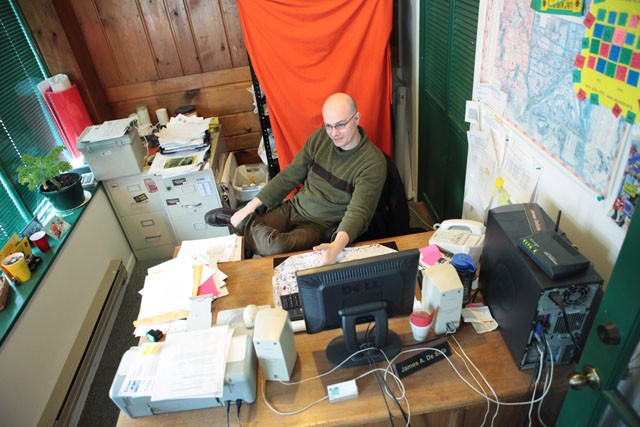For more than seven years the small building with green awnings on the corner of 15th and Rollins Avenues Southeast has been a symbol of a strong community presence in an eclectic neighborhood.
But now the organization housed there is leaving for a new place.
In March, the Southeast Como Improvement Association will begin moving its headquarters about a half-mile north to an office at 1170 15th Ave. SE.
The move is for financial reasons âÄî rent at the new location is half the $1,000 rate for the old place.
A large portion of SECIAâÄôs operating funds were derived from money allocated through the Neighborhood Revitalization Program. In December, the City of Minneapolis froze half of the remaining NRP funds, and SECIA was among many neighborhood organizations to be faced with an uncertain future.
âÄúItâÄôs a very tight economic climate for all nonprofits,âÄù said James DeSota, SECIAâÄôs director.
A number of other cost-cutting options, like cutting staff or only operating out of a website, were considered by the organizationâÄôs employees.
In the end, however, the group decided to do whatever needed to be done to keep SECIA going as usual, DeSota said.
The new 500-square-foot space, smaller than an already cramped 700-square-foot office in the current building, will save SECIA enough money to exist in the same capacity through the first half of 2012 âÄî about nine months longer than it would in the current place, DeSota said.
A staple location
But even with savings, moving comes at a cost. With the move, the organization is trading in its visibility âÄî something it has relied on in order to attract student attention.
The intersection of 15th and Rollins Avenues is right by a small tunnel thatâÄôs akin to a gateway into the neighborhood, said Adam Arling, SECIAâÄôs student representative. Where it stands now, SECIA sees a lot of the student foot traffic right outside its front door.
Though those already invested in the organization will stick with it, DeSota said the new location will hinder outreach.
âÄúWhat weâÄôll lack is the ability to reach out to the random student,âÄù he said.
DeSota is optimistic about the move. All change is difficult, he said, but it also allows for new opportunities like reaching out to parts of the neighborhood that were too far away from the current headquarters.
Having its own space
The University of Minnesota is surrounded by three other neighborhoods, all of which have their own organizations. But SECIA is the only one to have both an office and full-time paid staff.
Prospect Park East River Road Improvement Association is completely volunteer-based. The group keeps its costs as low as possible, trying not to rely too much on outside funding like from NRP, PPERRIA member Florence Littman said.
âÄúWeâÄôve always felt that the city giveth, and the city taketh away,âÄù she said.
Littman said there are people in the organization who would like to have an office and a staff, but she said that could change the nature of an organization.
But DeSota said itâÄôs a question of differences and community-specific needs.
Part of what makes SECIA stand out, DeSota said, is its focus on environmentalism and student involvement.
The organization has been working with the University community, including the Student Neighborhood Liaisons group, to promote community awareness.
Arling said the organization provides valuable resources to the students.
âÄúThat presence of SECIA at the gateway is pretty important for students to realize that there are residents and students that have a stake in this community,âÄù he said.
Arling said Student Neighborhood Liaisons will continue to work with SECIA. As long as the organization continues actually existing, he said, the move should not have much negative impact on student involvement.
Looking ahead
Though the moving and packing process will begin in March, the official opening date is set for April 1, DeSota said.
Along with the rent savings, the organization will be looking at other sources for funding.
Recently SECIA received around $36,000 from the City of Minneapolis as part of the cityâÄôs new Community Participation Program.
DeSota said that money will âÄúhelp keep the door open and the lights on.âÄù The real costs of running a program such as SECIA are greater, though, he said.
âÄúItâÄôs going to be very hard for neighborhood groups to survive the current climate,âÄù he said.
Right now DeSota is looking into submitting requests for grants with multiple foundations âÄî something heâÄôs done successfully in the past.

Image by Erin Westover
Cuts force a SECIA move
SECIA is the only University-area neighborhood organization with full-time paid staff.
Published February 14, 2011
0
More to Discover







